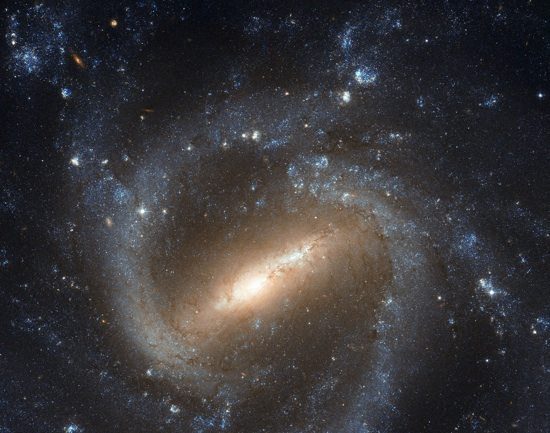We usually try to space out (groan) the astronomy items on Trebuchet a bit.
After yesterday's news that a super-Earth had been discovered, and the item we ran on the story, we'd normally move back to art and music news for a while.  But then we got this incredible image from NASA, and it just begs to be seen. Bear in mind that this new image comes from the orbiting Hubble telescope, and that even if it looks a lot like the splashy artist's impressions of galaxies we grew up with in Carl Sagan books and suchlike, in this case, it's not a painting. It's a photograph. Stunning.
But then we got this incredible image from NASA, and it just begs to be seen. Bear in mind that this new image comes from the orbiting Hubble telescope, and that even if it looks a lot like the splashy artist's impressions of galaxies we grew up with in Carl Sagan books and suchlike, in this case, it's not a painting. It's a photograph. Stunning.
The NASA/ESA Hubble Space Telescope has taken a picture of the barred spiral galaxy NGC 1073, which is found in the constellation of Cetus (The Sea Monster). Our own galaxy, the Milky Way, is a similar barred spiral, and the study of galaxies such as NGC 1073 helps astronomers learn more about our celestial home.
Most spiral galaxies in the Universe have a bar structure in their centre, and Hubble’s image of NGC 1073 offers a particularly clear view of one of these. Galaxies’ star-filled bars are thought to emerge as gravitational density waves funnel gas toward the galactic centre, supplying the material to create new stars. The transport of gas can also feed the supermassive black holes that lurk in the centres of almost every galaxy.

Some astronomers have suggested that the formation of a central bar-like structure might signal a spiral galaxy's passage from intense star-formation into adulthood, as the bars turn up more often in galaxies full of older, red stars than younger, blue stars. This storyline would also account for the observation that in the early Universe, only around a fifth of spiral galaxies contained bars, while more than two thirds do in the more modern cosmos.
More intriguing still, three of the bright points of light in this image are neither foreground stars from the Milky Way, nor even distant stars in NGC 1073. In fact they are not stars at all. They are quasars, incredibly bright sources of light caused by matter heating up and falling into supermassive black holes in galaxies literally billions of light-years from us. The chance alignment through NGC 1073, and their incredible brightness, might make them look like they are part of the galaxy, but they are in fact some of the most distant objects observable in the Universe.
Source: NASA/ESA

The aim of art is to represent not the outward appearance of things, but their inward significance. – Aristotle
















